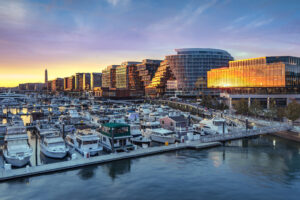in the news
Neha Vyas- Greenbuild Advisory Board 2024
Thursday, March 14, 2024
Sustainable Building Partners is ecstatic to announce the selection of our very own Neha Vyas to the esteemed Greenbuild 2024 Advisory Board. Neha’s inclusion in this distinguished panel is a testament to her unparalleled expertise and dedication to advancing sustainable practices in the construction industry. As an Advisory Board member, Neha will play a pivotal role in shaping the educational programming of Greenbuild 2024, addressing the pressing challenges confronting today’s leaders in their projects. Her keen insights and innovative approach will undoubtedly contribute to the development of dynamic materials that reflect industry trends, emerging topics, and invaluable feedback. We extend our heartfelt congratulations to Neha and eagerly anticipate the invaluable contributions she will make to this prestigious event!
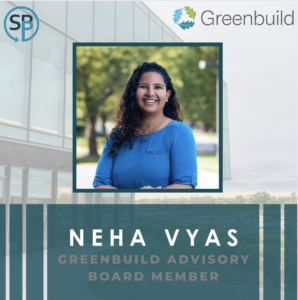
Women in Green
Thursday, March 7, 2024
We are proud to also announce our participation in the USGBC Carolinas Women in Green event on March 7th, in collaboration with CREW Charlotte. The event celebrated fresh perspectives in the built environment and explored equity, featuring a panel discussion on innovative sustainability practices. We were delighted to emphasize the crucial role of women in the green workforce and discuss the transformative potential of LEED initiatives in shaping a more sustainable future. The event was a tremendous success, and we are thrilled to have been a part of it.

New York State Green Building Conference
Friday, March 1, 2024
Sustainable Building Partners (SBP) is excited to share our participation in a sustainability event! We’re thrilled to announce our presence at the New York State Green Building Conference that took place February 29th, and Friday, March 1st. On Thursday, February 29th, we had the opportunity to present, “St. Elizabeth’s Shelter: A Beacon of Hope,” featuring speakers Rachel Nicely and Mike Babcock. As well as sharing, “Path to Net Zero goes beyond Handing over the Keys,” presented by Mike Babcock, Justin Aruck, and Adam Ugliuzza. SBP encouraged conference attendees to stop by and say hi to our team during the engaging event, where we explored innovative approaches to sustainable building practices and the latest advancements in the green building industry. We are proud to report that the event went exceptionally well, with insightful presentations and fruitful discussions that showcased our commitment to sustainability. Our team was thrilled to participate and connect with fellow industry professionals, sharing knowledge and exchanging ideas to further promote sustainable development.
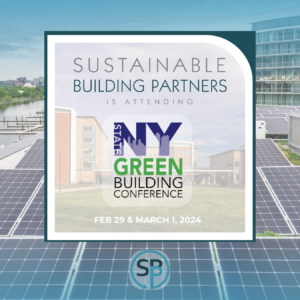
Woodlawn Fire Station 24- LEED Platinum
Tuesday, January 16, 2024
We are proud to announce Fairfax County’s first Platinum Fire Station, Woodlawn Fire Station 24. This project spans 15,082 square feet and has earned the prestigious LEED Platinum Certification, demonstrating its commitment to sustainability, energy efficiency, and operational excellence.
The Woodlawn Fire Station 24’s Platinum Certification is attributed to its adherence to the design and construction requirements of the LEED BD+C New Construction Rating System. One of the key contributors to this accomplishment is the installation of a cutting-edge ~50 kW rooftop solar array system. This innovative addition is projected to offset an impressive 27.92% of the total energy cost of the building, making it a beacon of environmentally conscious design.
Emphasizing both energy efficiency and operational excellence, the Woodlawn FS24 team implemented Enhanced Commissioning for both the HVAC systems and the PV system. This meticulous approach ensures the proper installation and optimal function of these systems, contributing to the overall efficiency and longevity of the facility.
Indoor air quality was a top priority for the Woodlawn FS24 team, considering the facility operates 24/7. Low-emitting materials were used for adhesives, sealants, paints, coatings, flooring systems, and composite wood materials, creating a healthy and comfortable environment for the station’s staff. An Indoor Air Quality Management Plan was also implemented and maintained throughout construction, ensuring that the building’s occupants enjoy superior air quality.
Additionally, the Woodlawn FS24 facility takes water conservation seriously, with the installation of low-flow plumbing fixtures. This strategic choice has resulted in a remarkable 51.26% reduction in expected annual indoor water use, equating to a saving of 143,791 gallons when compared to the LEED baseline.
Fairfax County’s Woodlawn Fire Station 24 stands as a shining example of a community’s dedication to sustainable infrastructure. The Platinum Certification reflects not only the commitment to environmental responsibility but also a holistic approach to building design and operation, creating a facility that serves the community efficiently and responsibly.
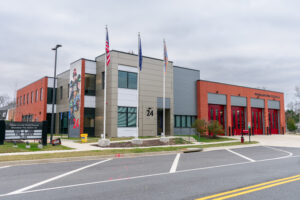
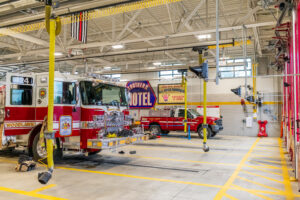
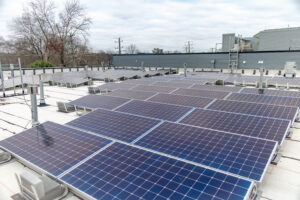
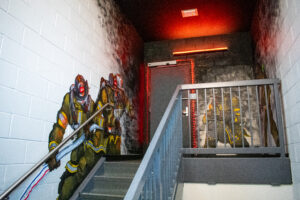
District Wharf Phase 2
Thursday, January 11, 2024
We are excited to announce that all buildings within Phase 2 of the District Wharf Neighborhood Development have achieved LEED certification this past year. This includes four projects, totaling over 1.2 million square feet, that have achieved LEED Silver, Gold, and Platinum certifications.
The District Wharf is a remarkable, mile-long stretch of redeveloped waterfront activity, years in the making. SBP has been working closely with the project team on sustainability initiatives since 2014.
Driven by the D.C. Office of Planning’s Waterfront Initiative in 2003, Hoffman-Madison Waterfront set out to reimagine the District’s southwest neighborhood. The public-private partnership strived to create a premiere waterfront neighborhood and destination that would be a focal point for D.C.’s community activity and achieve stringent sustainability goals. The entire 22-acre site is also designed as a LEED Gold Neighborhood Development, integrating elements of community connectivity throughout the project. A key element of the Neighborhood Development is the waterfront promenade that creates a walkable, social atmosphere for pedestrians and connects individuals to nature through the breathtaking views of the Potomac River.
The site not only includes alternative transportation options like bicycle parking and electric vehicle charging stations, but it also captures and manages rainwater on-site through permeable pavers, biosales, bioretention facilities, and underground cisterns. Additionally, it was a priority for the project team to reduce the building’s dependence on fossil fuels by incorporating highly efficient HVAC systems. Both 610 Water St. and 670-680 Maine Ave. buildings further incorporate rooftop solar panels, generating a combined 230,000 kWh of energy annually.
